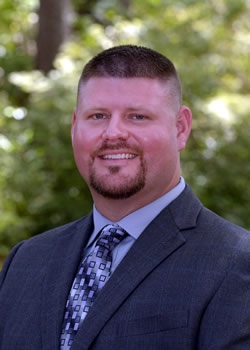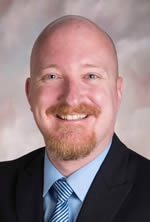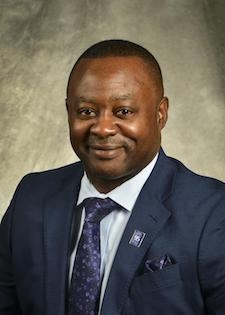SFA University
 August 4, 2021 — Stephen F. Austin State University’s Department of Agriculture reached a national audience when Dr. John Michael Mehaffey, associate professor of agriculture, appeared on RFD-TV Network’s “Texas Agriculture Matters.”
August 4, 2021 — Stephen F. Austin State University’s Department of Agriculture reached a national audience when Dr. John Michael Mehaffey, associate professor of agriculture, appeared on RFD-TV Network’s “Texas Agriculture Matters.”
The weekly television program, hosted by Texas Agriculture Commissioner Sid Miller, explores Texas-focused agricultural topics on the nation’s first 24-hour television network dedicated to agricultural programming, rural living and entertainment.
Mehaffey directs the SFA Swine Center located at the Walter C. Todd Agricultural Research Center and spoke about the importance of involving youth in agriculture through organizations such as the Four-H Club and National FFA Organization.
“I think it’s a huge step, especially in today’s world, to make sure we engage youth and let them know how important agriculture is,” Mehaffey said.
Although commercial swine production isn’t a top industry in Texas, the state is a national leader in producing quality pigs for livestock competitions.
Mehaffey said the SFA Swine Center annually places 100 to 150 show pigs with 4-H and FFA youth across East Texas.
The SFA Swine Show Team, comprising agriculture majors, also participates in regional, state and national shows using SFA-produced swine.
Due to the center’s involvement in show pig production, agriculture majors gain hands-on experience in livestock reproduction, nutrition, health and sales.
Mehaffey said this is increasingly important as more students from urban areas pursue careers in agriculture.
“In any given year, anywhere from 50 to 60% of our freshman class is from urban areas,” Mehaffey said. “Being from those urban areas, they have little experience with FFA and 4-H programs, or animals aside from dogs and cats. This makes SFA’s agricultural resources, facilities and research centers invaluable.”
To watch Mehaffey’s “Texas Agriculture Matters” segment, visit https://www.youtube.com/watch?v=WtpOGYjdKuY.
August 3, 2021 — Dr. Bob Szafran, former department chair and professor in Stephen F. Austin State University’s Department of Anthropology, Geography and Sociology, will offer the commencement address during the university’s two graduation ceremonies, Saturday, August 7.
Szafran received a bachelor’s degree from Loyola University of Chicago and a master’s and doctoral degree from the University of Wisconsin at Madison. Joining the SFA faculty in 1983, he has served in a variety of roles, including assistant dean and interim dean of the College of Liberal and Applied Arts. Szafran also served as a Regents Professor of Sociology.
Graduates and their guests must present tickets to enter Johnson Coliseum for commencement. Tickets are free but will help university officials ensure the venue is not overcrowded and adequate spacing can be maintained during the event. Each graduate will be allotted one ticket for themselves and a maximum of 15 guest tickets.
Candidates from the James I. Perkins College of Education and 2020 May and August graduates will participate in a 9:30 a.m. ceremony.
Candidates from the Rusche College of Business, the Arthur Temple College of Forestry and Agriculture, the College of Fine Arts, the College of Liberal and Applied Arts, and the College of Sciences and Mathematics will participate in a 12:30 p.m. ceremony.
Degrees to be awarded include 328 bachelor’s, 134 master’s and six doctoral degrees. Approximately 61 students will graduate with honors, including 31 cum laude, nine magna cum laude and 21 summa cum laude. Four will graduate with the university scholar designation.
The ceremony will be livestreamed on the SFA Facebook page, facebook.com/sfasu. For more information, visit sfasu.edu/commencement.

An artistic rendering of the 10 granite pillars to be installed on the SFA campus this fall. The monuments will pay homage to the National Pan-Hellenic Council and its “Divine Nine” historically black fraternities and sororities.
July 26, 2021 — Ten granite pillars to be installed on the Stephen F. Austin State University campus will pay homage to the National Pan-Hellenic Council and its “Divine Nine” historically black fraternities and sororities.
The 10-foot monuments will be erected in two rows of five along a pedestrian-only section of Raguet Street between the McGee Business and Miller Science buildings in the heart of campus. The name of each NPHC Greek organization will be engraved on one of the historic markers, and the 10th pillar will recognize the council as a whole.
“I am excited to see the continuous progress of SFA’s diversity, equity and inclusion initiatives through these monuments,” said Dr. Michara Delaney-Fields, SFA’s chief diversity officer. “This project demonstrates our constant commitment to creating a clear and concise path of transformative change.”
The $85,000 installation is being entirely funded through donations and will include lighting, landscaping and site beautification. SFA’s Student Government Association and Interfraternity Council already have contributed to the project. Organizers are hoping the monuments can be funded and installed in time for SFA Homecoming in late October.
“These monuments will provide greater visibility for our historically black fraternities and sororities, as well as honor the historic legacy of these organizations on our campus and across the country,” said Saville Harris, a 2010 and 2013 graduate of SFA and a member of Alpha Phi Alpha Fraternity. Until recently, Harris served as the SFA assistant director of student engagement-Greek life, and has been instrumental in the project’s planning.
Engraved benches will be placed between each marker in the colonnade, which is designed to be a place of reflection and remembrance, a designated space for NPHC celebrations and ceremonies, and a destination for campus guests and visiting alumni. Similar installations honoring historically black Greek organizations are located at Texas Christian University and Baylor University.
“Walking through these columns, I think people will get the sense of being in a cathedral or coliseum or some other place of great history, tradition and reverence,” Harris said. “It is going to be a phenomenal addition to the campus.”
Shamia Gipson, a 2020 SFA graduate and past president of SFA’s chapter of NPHC, said the idea for the project grew out of conversations she and Harris often shared about how historically black Greek organizations could be more visible on campus.
“We started talking about NPHC monuments at other universities and how much we would love to have something bold and lasting to spread awareness about the importance of these groups at SFA,” said Gipson, who is a member of Alpha Kappa Alpha Sorority. “It is really humbling and exciting to think that those conversations eventually led to this project being approved, and the incredible history and contributions of these organizations are going to be recognized and celebrated.”
Gipson’s sorority sister Courtney Bradley, a recent SFA graduate who served as the NPHC president during the spring 2021 semester, said she is most excited about the impact the project could potentially have on current and future students.
“One of the most important things in regard to student success is having representation, seeing people who look like you be successful in college and beyond,” Bradley said. “These monuments will be a sacred, historical marker for my culture and my community, a celebration of how far we have come and how far we can go in the future.”
The monuments will be created and installed by SFA alumni-owned Martus Stone-Nacogdoches Monument Company, which is completing the project for the cost of materials alone, according to wholesale manager and two-time SFA graduate Jenny Rhodes.
“We are Lumberjacks, once and always. We’re family,” Rhodes said. “When SFA reached out and we saw the need, we never hesitated. What these monuments stand for — the magnitude of the statement they are going to make for past, current and future students — it was just a no-brainer for us. We can’t wait to start.”
The NPHC comprises nine member organizations dedicated to promoting camaraderie, academic excellence and community service. The organizations, known collectively as “The Divine Nine,” include Alpha Phi Alpha, Alpha Kappa Alpha, Kappa Alpha Psi, Omega Psi Phi, Delta Sigma Theta, Phi Beta Sigma, Zeta Phi Beta, Sigma Gamma Rho and Iota Phi Theta.
To donate to the marker project, visit sfasu.edu/nphc. Those who donate $1,000 or more will be recognized as a sponsor during the ribbon-cutting ceremony.
For more information, contact the SFA Office of Development at (936) 468-5406 or givetosfa@sfasu.edu.
Story by Amy Roquemore, director of student publications and divisional media for the SFA Division of Student Affairs.
 July 23, 2021 - Stephen F. Austin State University has named a new assistant vice president for student affairs to serve as dean of students.
July 23, 2021 - Stephen F. Austin State University has named a new assistant vice president for student affairs to serve as dean of students.
Andrew J. Dies recently served as dean of students at Northern Arizona University, where he was chief student conduct officer and the primary contact for students in crisis, in addition to serving on the emergency management team and the academic standards committee.
Dies previously served as dean of students and student affairs campus lead at the Armstrong and Liberty campuses of Georgia Southern University. During his higher education career, he has led or served on committees dedicated to student behavioral intervention, threat assessment, and Clery Act Compliance.
“We had a very strong applicant pool from this national search, and Andrew’s commitment to student success and advocacy stood out during the interview process,” said Dr. Brandon Frye, SFA vice president for student affairs. “He has demonstrated a commitment to helping students throughout his career, and we believe he will be a dynamic and collaborative leader focused on student support, well-being, safety, belonging, resilience and success.”
Dies received his Bachelor of Social Work from the University of Kansas at Lawrence and his Master of Education in higher education administration from North Carolina State University in Raleigh. He is currently completing his dissertation at Georgia Southern University for a doctoral degree in educational leadership.
“I’m excited to join the SFA family,” Dies said. “The student affairs team at the university is highly talented, and I look forward to working with the great students who attend SFA.”
Dies will begin in his new role on August 9, with responsibility for the development and management of Student Rights and Responsibilities, the Behavioral Intervention Team, Counseling Services, Campus Recreation and Health Services. He also will provide advisement of the Student Government Association.
July 22, 2021 — Stephen F. Austin State University’s SFA Gardens will host its monthly Lunch Bunch event from noon to 1 p.m. Wednesday, August 18, at the Brundrett Conservation Education Building, 2900 Raguet St., in historic Nacogdoches.
Participants should bring their own lunch and join staff members from SFA Gardens as they share the topics of this year’s Lunch Bunch meetings, which are geared toward garden-minded individuals.
This event raises awareness for upcoming SFA Garden’s events and volunteer opportunities, including at SFA Gardens plant sales and weekly landscape upkeep on the SFA Gardens grounds. Parking will be available at the nearby Pineywoods Native Plant Center.
For more information, call (936) 468-4404 or visit sfagardens.sfasu.edu.
July 8, 2021 — The Stephen F. Austin State University Police Department recently received accreditation from the International Association of Campus Law Enforcement Administrators, the leading authority for campus public safety. Fewer than 100 agencies have earned this endorsement from IACLEA, which indicates compliance with national best-practice standards in the profession.
 “All employees worked diligently to complete this challenging process, and we did so because of our commitment to excellence and a desire to provide professional police services throughout our community,” said SFA Chief of Police John Fields.
“All employees worked diligently to complete this challenging process, and we did so because of our commitment to excellence and a desire to provide professional police services throughout our community,” said SFA Chief of Police John Fields.
IACLEA accreditation signifies an agency’s ongoing commitment to excellence and state-of-the-art performance in every aspect of its operations. SFA President Scott Gordon said the university’s accreditation is well-deserved.
“The SFA Police Department demonstrates the highest level of practices, operations and professionalism each and every day,” Gordon said. “I commend Chief Fields and his officers for the tremendous job they do and their commitment to excellence.”
The accreditation standards guide the recruitment, selection, training, and professional development of agency personnel and overall agency operations.
“We congratulate SFA on achieving IACLEA accreditation, a unique distinction among campus police and public safety agencies,” said IACLEA President Eric Heath, associate vice president for Safety & Security at the University of Chicago. “The men and women protecting campus have proven through policy and practice the commitment to operate at the highest level of the profession.”
The department prepared for the onsite assessment by updating policies and operations and ensuring the public had the opportunity to provide comments to the assessors during the onsite visit.
Fields said the department will seek re-accreditation in four years. For more information about SFA’s UPD, visit www.sfasu.edu/upd.
June 25, 2021 — Stephen F. Austin State University’s DeWitt School of Nursing was recently ranked No. 8 in Texas by RN Careers, an online program guide.
RN Careers ranks programs based on tuition costs and national licensure exam pass rates, among other criteria.
The DeWitt School of Nursing received a 97% first-time pass rate on the National Council Licensure Examination in 2020 and prepares students for success with personal attention from faculty.
“Our nursing faculty are engaged and focused on student success,” said Dr. Tamara Harris, director of the School of Nursing. “We have testing procedures that mimic the NCLEX testing and faculty that accompany students to clinicals for the purpose of reinforcing concepts from lecture content.”
With advanced simulation labs and rigorous coursework, students are equipped to provide exceptional patient care in a variety of nursing fields.
“Our students graduate with job offers,” Harris said. “SFA’s School of Nursing has a reputation across the state of providing a great education for nurses.”
To learn more about the School of Nursing, visit sfasu.edu/nursing.
By Joanna Armstrong, marketing communications specialist at Stephen F. Austin State University.

Dr. Christopher Schalk, SFA assistant professor of forest wildlife management, and Dr. Daniel Scognamillo, SFA adjunct professor of forest wildlife management, participated in the first nationwide survey of mammals initiated by the North Carolina Museum of Natural Sciences and the Smithsonian Conservation Biology Institute. The survey, known as Snapshot USA, comprises 1,509 motion-activated camera traps throughout 110 sites in the U.S. Pictured is a common raccoon documented at the Stephen F. Austin Experimental Forest during the survey.
June 16, 2021 — Have you ever felt as though you were being watched? If so and you were a mammal roaming the 2,560-acre Stephen F. Austin Experimental Forest during fall 2019, your suspicions likely were correct.
Dr. Christopher Schalk, Stephen F. Austin State University assistant professor of forest wildlife management, and Dr. Daniel Scognamillo, SFA adjunct professor of forest wildlife management, are two of more than 150 researchers from across the continental U.S. to participate in the first nationwide survey of mammals initiated by the North Carolina Museum of Natural Sciences and the Smithsonian Conservation Biology Institute.
The survey, known as Snapshot USA, comprises 1,509 motion-activated camera traps throughout 110 sites in the U.S.
“Our goal was to provide a space for researchers from all 50 states to contribute a subset of their data to a broader initiative to maximize our coverage of the country and better understand drivers of mammal distributions to best inform conservation as rapidly as possible,” said Michael Cove, curator of mammalogy at the North Carolina Museum of Natural Sciences.
Schalk and Scognamillo deployed 19 camera traps throughout the SFA Experimental Forest during September and October 2019 and recorded numerous observations of more than 10 mammal species, including white-tailed deer, Southern flying squirrel, bobcat, coyote and nine-banded armadillo.
“These data are really valuable because they allow researchers to address questions and problems on the ecology and conservation of mammals at broader spatial scales,” Schalk said.
The results of Snapshot USA were featured in Ecology, a peer-reviewed journal published by the Ecological Society of America. The 2019 survey data also is publicly available at emammal.si.edu/snapshot-usa.
Story by Sarah Fuller, outreach coordinator for Stephen F. Austin State University’s Arthur Temple College of Forestry and Agriculture.

The ongoing collaboration between art education students at Stephen F. Austin State University and the Nacogdoches membership of the Boys and Girls Clubs of Deep East Texas has resulted in an art show available for viewing from noon to 5 p.m. Saturday, June 19, at The Cole Art Center at The Old Opera House in downtown Nacogdoches.
June 14, 2021 – The first Boys and Girls Club Art Show will be presented from noon to 5pm Saturday, June 19, at The Cole Art Center at The Old Opera House in downtown Nacogdoches.
The show is part of an ongoing collaboration between art education students at Stephen F. Austin State University and the Nacogdoches membership of the Boys and Girls Clubs of Deep East Texas. On display will be artwork created as a result of art education student-lead art lessons presented at the Boys and Girls Club since March.
“SFA art education students have been providing art lessons continuously since the summer of 2020,” said Dr. Maggie Leysath, professor of art education at SFA. “The art lessons are part of an initiative by the art education department to help the BGC build an after-school art program by providing art lessons taught by SFA art education students.
Lessons were initially provided virtually because of the pandemic. But in March, art education students were able to resume face-to-face art lessons at the club facilities and develop a body of work that will be on display in the art show and is representative of the on-going collaboration, according to Leysath.
“BGC members as well as interested community members are invited to join us to share the artwork created by BGC members after school and during the Summer 2021 session,” Leysath said.
Light refreshments will be served just outside the upper gallery where the exhibition will be held. The Cole Art Center is located at 329 E. Main St.
For more information about the show, contact Leysath at leysathmn@sfasu.edu or 936-468-4262. For more information about summer programs with the Boys and Girls Clubs of Deep East Texas, visit bgcdet.org. For more information about the School of Art, visit art.sfasu.edu.

Construction continues on Griffith Fine Arts Building on the SFA campus. The Fine Arts Expansion Initiative will extend the building along North Street. The renovated and expanded state-of-the-art building will also include two dance studios, two new theatres, recording studio, sound stage, audio and video editing rooms, an art gallery, multiple classrooms, rehearsal facilities, faculty offices and the offices of the College of Fine Arts dean. The facilities will house the CFA’s sound recording technology, filmmaking, theatre, dance and musical theatre programs.
June 8, 2021 - Despite the obstacles created by Mother Nature and a worldwide pandemic, construction and renovation work at Griffith Fine Arts Building on the Stephen F. Austin State University campus continues to move forward.
This summer, those passing the building situated on the corner of North and East College streets will see “a building rise from underground and new life be given to the existing structure,” according to Jessica DeWitt, project manager and assistant director of projects and construction at SFA.
The Fine Arts Expansion Initiative will extend the Griffith building along North Street. The project will include renovations to W.M. Turner Auditorium, and the state-of-the-art building will also feature two dance studios, two new theatres, recording studio, sound stage, audio and video editing rooms, an art gallery, multiple classrooms, rehearsal facilities, faculty offices and the offices of the College of Fine Arts dean. The facilities will house the CFA’s sound recording technology, filmmaking, theatre, dance and musical theatre programs.
“This new, fantastic facility is going to be a beehive of activity for decades to come,” said Gary Wurtz, interim dean of the College of Fine Arts. “Watching the progress from a window or through a chain-link fence is both exciting and a test of our patience. The opportunities it will offer for teaching, learning, performing and exhibiting are endless, and we simply can’t wait to move in.”
Building design is by Kirksey Architecture and construction is by KDW. The project, which was designed to take place in two major phases including renovation of the existing building and construction of a new addition, is in various stages of work, Dewitt explained.
“In the renovation of the existing building, there is a lot of above-ceiling rough-in work for plumbing, electrical, internet and air distribution,” she said. “These activities are going to take care of the building’s deferred maintenance needs and bring those systems back online more efficiently.
“The construction of the new addition is in the critical stage of pouring the foundation and underground structure,” she said. “This has been quite the feat, given we are building down instead of up. We’re having to adapt to the slope of the site and maintain the overall relationship to the existing building.”
Adding to the anticipated challenges of a project like this, major winter storms and recent rains, along with a wide range of delays relating to materials and labor as a result of the global pandemic and overall changes in the world have created additional trials, DeWitt explained.
“Thankfully, KDW has picked up some ‘lessons learned’ from the construction of SFA’s new basketball facility to keep work on track,” she said. “As a project management team, it is our job to watch the market, stay in contact with sources, and keep things flexible at all times. To say a project is going ‘as planned,’ or not, is an unfair assessment to the process; the plan is always moving, but our target is clear.”
While it is still too early to narrow down a completion date, DeWitt said the project management team has “strong expectations” that the building will be available for occupancy in mid 2023.
To view design plans and artists’ renderings, and for up-to-date construction progress, visit finearts.sfasu.edu/expansion.









